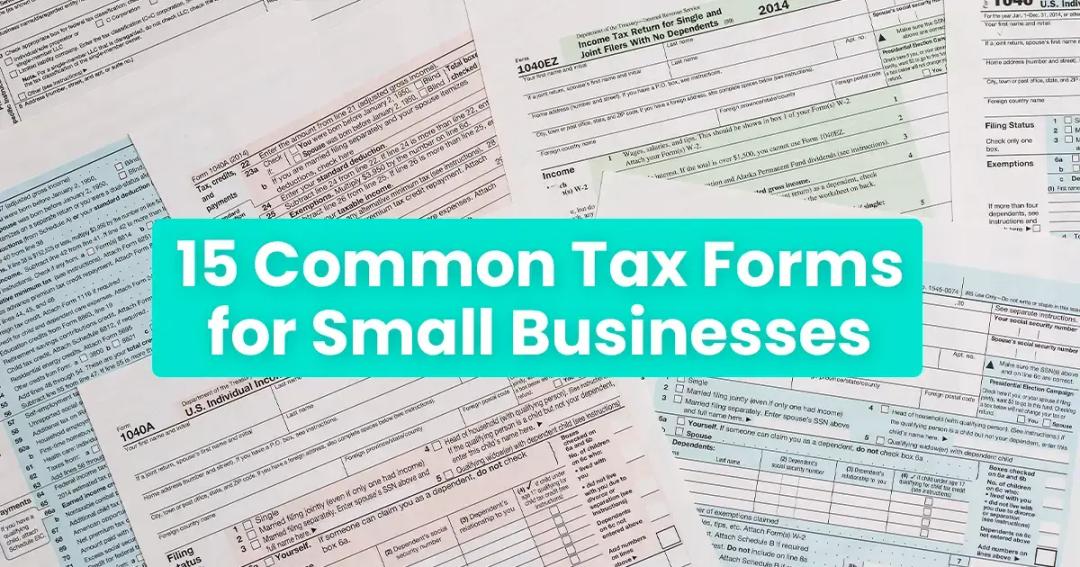
When tax time arrives, many small businesses will need to complete tax forms. The exact form the business needs will depend on several factors.
There are many tax forms that businesses will have to file. Here are the most common business tax forms and the basics about each.
Most Common Business Tax Forms
The exact business tax form that you’ll need will depend on your business entity type. Below is a list of the most common business tax forms:
- Form 940 (Federal Unemployment (FUTA) Tax Return)
- Form 941 (Employer’s Quarterly Federal Tax Return)
- Form 944 (Employer’s Annual Federal Tax Return)
- Form 1040 (U.S. Individual Income Tax Return)
- Form 1040-ES (Estimated Taxes for Individuals)
- Form 1040-X (Amended U.S. Individual Tax Return)
- Form 1065 (U.S. Return of Partnership Income)
- Form 1120 (U.S. Corporation Income Tax Return)
- Form 1120-S (U.S. Income Tax Return for an S-Corp)
- Form 4562 (Depreciation and Amortization)
- Form W-2 (Wage and Tax Statement)
- Form W-3 (Transmittal of Wage and Tax Statements)
- Form W-4 (Employer’s Withholding Certificate)
- Schedule C (Profit or Loss from Business)
- Schedule K-1 (Partner’s Share of Income, Deductions, Credits)
How to File a Small Business Tax Return
Filing a small business tax return is a multi-step process. It consists of:
- Collecting the necessary records
- Finding appropriate forms
- Filling out forms
- Monitoring deadlines
Business Tax Forms to Know
The exact business form you’ll need will depend on your business entity. Below is a list of business tax forms.
Estimated tax
- Form 1040-ES, Estimated Tax for Individuals, is the form you’ll use to pay taxes on income not subject to withholding. This guide will help you learn more about calculating estimated taxes.
Payroll tax
There are multiple forms used for payroll taxes:
- Form W-2, Wage and Tax Statement, is the form you’ll use if you withheld income, Medicare tax, or social security.
- You’ll also use this form if you paid $600 or more in wages, even if you didn’t withhold any income, Medicare tax, or social security.
- Form W-3, Transmittal of Wage and Tax Statements, is the form you’ll use to transmit Copy A forms of W-2.
- Employers with at least one household employee must also file Form-W3.
- Form 940, Employer’s Annual Federal Unemployment (FUTA) Tax Return, is the form you’ll use to report your annual FUTA tax.
- Only employers pay this tax.
- Form 941, Employer’s Quarterly Federal Tax Return, is a form employers use to report income taxes, Medicare tax, and Social Security tax.
- Form 944, Employer’s Annual Federal Tax Return, is a form employers use to pay the above taxes annually instead of quarterly.
- Form 1094-B, Transmittal of Health Coverage Information Returns, is the form. You must file Form 1094-B with Form 1095-B.
- Form 1095-B, Health Coverage, is the form that you’ll use to report information to the IRS and taxpayers about individuals covered by minimum essential coverage.
- Form 1094-C, Transmittal of Employer-Provided Health Insurance Offer and Coverage Information Returns, is the form employers will use if required to offer employer health insurance under the Affordable Care Act (ACA).
- You must file Form 1094-C with Form 1095-C.
- Form 1095-C, Employer-Provided Health Insurance Offer and Coverage, is the form a company will use if it is an Applicable Large Employer (ALE).
- An ALE must have at least 50 full-time employees during the prior year to become one for the current calendar year.
You can also use this comprehensive payroll tax guide to learn more about payroll taxes as a business owner.
Deduction
- Form 1040, U.S. Individual Income Tax Return, is the form you’ll use to figure out your itemized deduction.
- Your federal income tax may decrease if you take the larger of your itemized deductions or your standard deduction.
- Form 1040-SR, U.S. Tax Return for Seniors, is an alternative to Form 1040, available for taxpayers who are age 65 and older.
- Form 1040-SR uses the same instructions and schedules as Form 1040.
Exemptions
- Form W-4, Employee’s Withholding Certificate, is the form you’ll use so that your employer deducts the correct federal income tax from your pay.
Depreciation
- Form 4562, Depreciation and Amortization, is the form you’ll use to:
- Claim your deduction for depreciation and amortization.
- Make the election under section 179 to expense certain property.
- Provide information on the business or investment use of automobiles and other listed property.
- Within Form 4562, you’ll provide information about your property.
- You’ll attach this form to your tax return.
Tax Structure
- Form 1065, U.S. Return of Partnership Income, is the form you’ll use to report a partnership’s credits, deductions, income, gains, or losses.
- Form 1120, U.S. Corporation Income Tax Return, is the form a corporation uses to report its credits, deductions, income, gains, or losses.
- Corporations can also use this form to figure out their income tax liability.
- Form 1120-S, U.S. Income Tax Return for an S-Corporation, is the form an S-Corp uses to report its credits, deductions, income, gains, or losses.
- Other entities choosing to experience taxation as an S-Corp will also use this form.
- Schedule C, Profit or Loss from Business, is the form a sole proprietor uses to report the costs of goods sold, expenses, income, and other expenses.
- Schedule K-1, Partner’s Share of Income, Deductions, Credits, is the form a partner will use to report their share of the partnership’s credits, deductions, or income.
Extension
- Form 1138, Extension of Time for Payment by a Corporation Expecting a Net Operating Loss Carryback, is the form a corporation will use.
- Corporations will use this form if it expects a net operating loss in the current tax year.
- This form allows the corporation to extend its payment time until the immediately preceding tax year.
- Form 7004, Application for Automatic Extension of Time to File Certain Business Income Tax, Information, and Other Returns, is the form you’ll use to request:
- An automatic, six-month extension to file certain:
- Business income tax
- Information
- Other returns
- An automatic, six-month extension to file certain:
Check out this comprehensive guide on how to file business tax extensions as a small business owner.
Audit
- Form 1040-X, Amended U.S. Individual Income Tax Return, is the form that you’ll use to:
- Change amounts previously adjusted by the IRS.
- Correct Forms 1040, 1040-A, 1040-EZ, 1040-NR, or Form 1040-NR EZ.
- Claim a carryback due to a loss or unused credit.
- Make certain elections after the prescribed deadline.
- You can file Form 1040-X electronically or by paper filing.
Work with Business Tax Professionals
Completing your business tax forms accurately and on time is both vital and challenging. For a stress-free experience and expert assistance, consider partnering with our tax professionals at 1-800Accountant. Our team of business tax professionals stays up-to-date with tax laws and helps you avoid penalties and saves time. We provide a wide range of tax services that can free up your time, allowing you to concentrate on running your business.
This post is to be used for informational purposes only and does not constitute legal, business, or tax advice. Each person should consult his or her own attorney, business advisor, or tax advisor with respect to matters referenced in this post. 1-800Accountant assumes no liability for actions taken in reliance upon the information contained herein.

